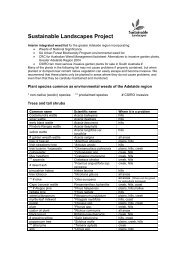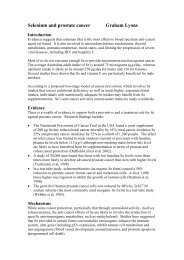The Therapeutic Design of Environments for ... - The Gerontologist
The Therapeutic Design of Environments for ... - The Gerontologist
The Therapeutic Design of Environments for ... - The Gerontologist
You also want an ePaper? Increase the reach of your titles
YUMPU automatically turns print PDFs into web optimized ePapers that Google loves.
Other design guidance does demand verificationthrough empirical research, however. Empirical researchis needed to resolve situations in which conflictingdesign recommendations are <strong>of</strong>fered. Researchis also warranted when recommended designsolutions are <strong>of</strong> unknown effectiveness or when designrecommendations have major or controversialimpacts <strong>for</strong> cost or quality <strong>of</strong> life. Research on designand dementia has been conducted in earnest since atleast 1980, yet findings <strong>of</strong> many studies remain unknownamong designers and facility administrators.In the following sections, we review and analyze existingstudies <strong>of</strong> design and well-being <strong>for</strong> peoplewith dementia to enhance the design <strong>of</strong> dementia facilitiesand to provide direction <strong>for</strong> future research.MethodsSeveral strategies were used to identify potentialstudies <strong>for</strong> review. <strong>The</strong> first involved a key-wordsearch <strong>of</strong> four major databases: Psych Abstracts,Medline, MAGS, and CAT (see Appendix A, Note 2).Potential studies were also identified by reviewing allissues (1980 or later) <strong>of</strong> several journals in gerontologyand environment-design research (see AppendixA, Note 3). Finally, reference lists were inspected <strong>for</strong>all studies included in this review. In each case, articles,books, and chapters identified as potentially relevant(by title and by abstract if available) were collectedand assessed <strong>for</strong> appropriateness.Studies included in this review met the followingcriteria: a report <strong>of</strong> empirical research (see AppendixA, Note 4), published 1980 or later (see Appendix A,Note 5), written in English, with an emphasis on peoplewith dementia or their families or staff caregivers,and with a substantial (though sometimes secondary)emphasis on the relationship between the design <strong>of</strong>the physical environment and the well-being <strong>of</strong> peoplewith dementia, their families, and/or staff. For thisreview, the physical environment was loosely definedas the domain <strong>of</strong> relevance to architects, interiordesigners, facility managers, and/or administratorsor caregivers undertaking environmental designor renovation. Thus, research on issues such as lighting,furnishings, and outdoor space was included.Research on microscale “product” design (e.g., prostheticdevices to facilitate eating) or on the sensory orsocial environment outside the purview <strong>of</strong> designers(e.g., incorporation <strong>of</strong> music and pets) was excluded, aswere studies that did not examine actual environmentsor actual impacts. Well-being was defined broadly, toinclude factors such as residents’ activities <strong>of</strong> daily living(ADL), physical well-being, cognitive function, andproblem behaviors; family members’ well-being; andstaff well-being and job per<strong>for</strong>mance. Seventy-one researchreports were included in the review. Because <strong>of</strong>this selective search strategy, we may have overlookedsome relevant material in the review.Research <strong>Design</strong> and Sample SizeMuch research on design and dementia comprisessmall size samples. For example, more than 30% <strong>of</strong>the studies reviewed used samples <strong>of</strong> fewer than 30participants; many included less than 10 participants.Sample sizes reflect the limited populations <strong>of</strong> residentsat the single facility in which many studieswere conducted, the high rates <strong>of</strong> resident mortality,and facilities’ limited populations <strong>of</strong> residents incomparable stages <strong>of</strong> dementia. Although they raiseconcern <strong>for</strong> the validity and generalizability <strong>of</strong> findings,studies with small samples were included so asnot to severely restrict the scope <strong>of</strong> this review. Researchdesigns and samples are described in Table 1.Results<strong>The</strong> rate <strong>of</strong> research on design and dementia is increasing:from 6 research reports from 1981–1985, to17 research reports from 1986–1990, to 26 researchreports from 1991–1995, and to 21 research reportsalready published since 1996 (see Table 1). This sectionsummarizes findings from the research reportsreviewed, according to the organizational frameworkpresented earlier (i.e., planning principles, general attributes<strong>of</strong> the environment, building organization,and specific rooms and activity spaces). <strong>The</strong> summaryis followed by a discussion and analysis <strong>of</strong> existingresearch on design and dementia.Planning Principles<strong>The</strong>se studies examine broad decisions regardingthe development <strong>of</strong> dementia care settings. Studiesexamined impacts <strong>for</strong> well-being following relocation<strong>of</strong> people with dementia to new environments,use <strong>of</strong> respite and day care environments and <strong>of</strong> specialcare units (SCUs), and exposure to various groupsizes <strong>of</strong> residents.Relocation to New <strong>Environments</strong>.—Findings aremixed regarding the impacts <strong>of</strong> relocating peoplewith dementia to new environments (Robertson,Warrington, & Eagles, 1993; Seltzer et al., 1988; seeAppendix A, Note 6). When moved together as intactunits <strong>of</strong> residents and staff, people with dementia appearto suffer few or no adverse impacts from relocation(Anthony, Procter, Silverman, & Murphy, 1987;McAuslane & Sperlinger, 1994; Robertson et al.,1993). <strong>The</strong> more pleasant environment <strong>of</strong> a new facilitymay partially explain the lack <strong>of</strong> negative impact<strong>for</strong> relocated residents (according to McAuslane& Sperlinger, 1994). In contrast, residents with dementiawho are moved individually appear to sufferhigher rates <strong>of</strong> depression and mortality following relocation(Anthony et al., 1987; Robertson et al.,1993). This effect holds when residents undergo orientationto ease relocation. Staff members also reportdecreased job satisfaction (attributed to anxiety) priorto moving, which returns to premove levels <strong>of</strong> satisfactionfollowing relocation (McAuslane & Sperlinger,1994).Respite <strong>Environments</strong>.—Respite environments <strong>of</strong>fertemporary care <strong>for</strong> people with dementia and providerelief to families. <strong>The</strong> impacts <strong>of</strong> respite environ-398 <strong>The</strong> <strong>Gerontologist</strong>
















